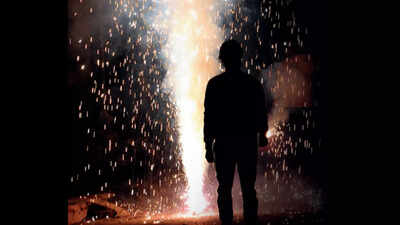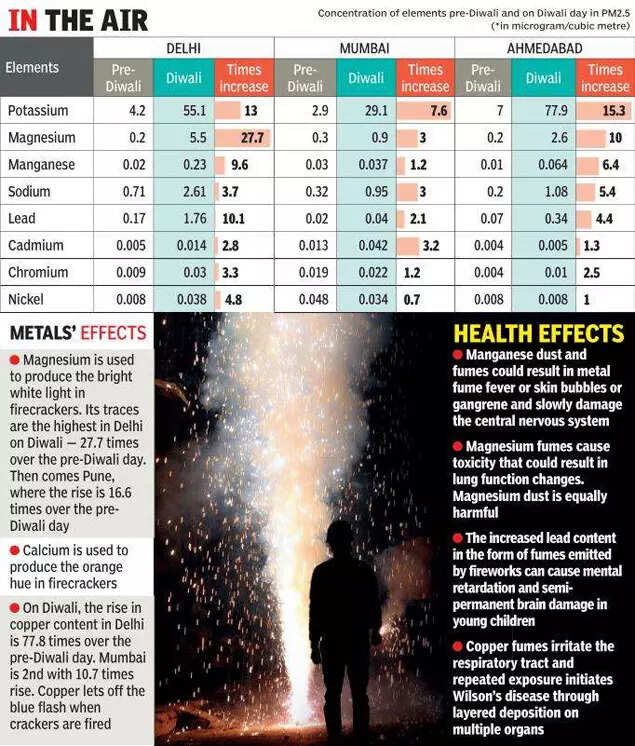- News
- City News
- ahmedabad News
- What festive skies cough out

Representative image
AHMEDABAD: Festivities turn our skies into a beautiful kaleidoscope of fireworks. Experts and government pollution watchdogs have for long warned against the rising particulate matter PM2.5. But few have deciphered the nature of particles that make up the smoke.

Recently, the Indian Institute of Tropical Meteorology (IITM), Pune, and a few other institutions released a report on the substances that remained suspended in Ahmedabad’s air after the Diwali night in 2018-19.
The researchers showed that potassium content increased 15.3 times after Diwali over the previous day. Magnesium compound particles went up 10 times, manganese content shot up 6 times, while lead and sodium content surged 4 times.
Ahmedabad had the second highest average PM2.5 concentration on Diwali day with the Rakhial station topping the charts at 353 microgram per cubic metre. GIFT City saw the least concentration, 89 microgram per cubic metre.
Unlike in other cities, in Ahmedabad, most stations showed peak values in close range, the study said. The study covered 1,050 square kilometre area.
The study also observed that the PM10 (dust level) difference between Diwali and pre-Diwali day was 1,407 microgram per cubic metre, while the difference was 746 microgram per cubic metre for PM2.5 particulate pollution.
“Pune comes third with the Pashan station having PM2.5 at 67 microgram per cubic metre and Hadapsar at 257 microgram per cubic metre as Diwali day peaks which are minimum and maximum respectively in the range,” the study said.
It added, “It was seen that PM2.5 and PM10 in Delhi increased by 353% and 213% respectively.”
In Pune and Ahmedabad, the enhancement in PM2.5 was half of that of Delhi while the effect in Mumbai was just one-seventh of Pune, where variation is atypical to other cities, the research said.

Recently, the Indian Institute of Tropical Meteorology (IITM), Pune, and a few other institutions released a report on the substances that remained suspended in Ahmedabad’s air after the Diwali night in 2018-19.
The researchers showed that potassium content increased 15.3 times after Diwali over the previous day. Magnesium compound particles went up 10 times, manganese content shot up 6 times, while lead and sodium content surged 4 times.
The study was conducted by IITM’s Latha Radhadevi, Vrinda Anand, Nikhil Korhale, Pramod Kori, and Murthy Bandaru. The study covered Delhi, Pune, and Mumbai too.
Ahmedabad had the second highest average PM2.5 concentration on Diwali day with the Rakhial station topping the charts at 353 microgram per cubic metre. GIFT City saw the least concentration, 89 microgram per cubic metre.
Unlike in other cities, in Ahmedabad, most stations showed peak values in close range, the study said. The study covered 1,050 square kilometre area.
The study also observed that the PM10 (dust level) difference between Diwali and pre-Diwali day was 1,407 microgram per cubic metre, while the difference was 746 microgram per cubic metre for PM2.5 particulate pollution.
“Pune comes third with the Pashan station having PM2.5 at 67 microgram per cubic metre and Hadapsar at 257 microgram per cubic metre as Diwali day peaks which are minimum and maximum respectively in the range,” the study said.
It added, “It was seen that PM2.5 and PM10 in Delhi increased by 353% and 213% respectively.”
In Pune and Ahmedabad, the enhancement in PM2.5 was half of that of Delhi while the effect in Mumbai was just one-seventh of Pune, where variation is atypical to other cities, the research said.
FacebookTwitterLinkedinEMail
Start a Conversation
end of article
Quick Links
Delhi Air PollutionDelhi TemperatureChennai WeatherBangalore TemperatureCovid vaccination centres in DelhiCoronavirus in DelhiRTPCR test in GurgaonHyderabad RainPollution level in BangaloreDelhi SmogDelhi TemperatureNoida AQIGurgaon AQI todayFire in MumbaiMumbai RainsCovid 19 RT PCR Test in NoidaDelhi AQI todaySrinagar encounter

